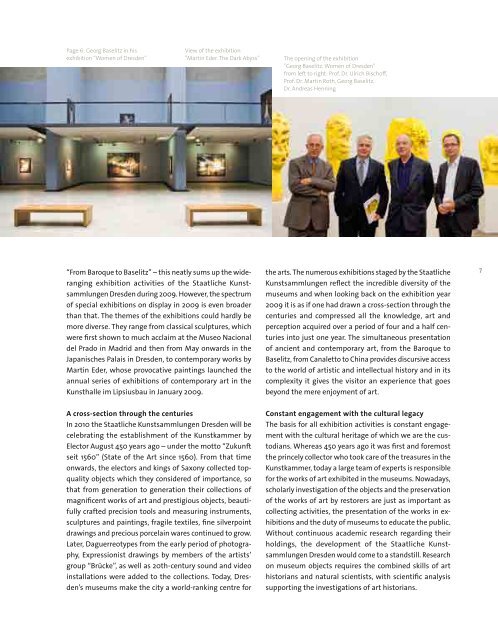2009 - Staatliche Kunstsammlungen Dresden
2009 - Staatliche Kunstsammlungen Dresden
2009 - Staatliche Kunstsammlungen Dresden
You also want an ePaper? Increase the reach of your titles
YUMPU automatically turns print PDFs into web optimized ePapers that Google loves.
Page 6: Georg Baselitz in his<br />
exhibition “Women of <strong>Dresden</strong>”<br />
“From Baroque to Baselitz” – this neatly sums up the wideranging<br />
exhibition activities of the <strong>Staatliche</strong> <strong>Kunstsammlungen</strong><br />
<strong>Dresden</strong> during <strong>2009</strong>. However, the spectrum<br />
of special exhibitions on display in <strong>2009</strong> is even broader<br />
than that. The themes of the exhibitions could hardly be<br />
more diverse. They range from classical sculptures, which<br />
were first shown to much acclaim at the Museo Nacional<br />
del Prado in Madrid and then from May onwards in the<br />
Japanisches Palais in <strong>Dresden</strong>, to contemporary works by<br />
Martin Eder, whose provocative paintings launched the<br />
annual series of exhibitions of contemporary art in the<br />
Kunsthalle im Lipsiusbau in January <strong>2009</strong>.<br />
A cross-section through the centuries<br />
In 2010 the <strong>Staatliche</strong> <strong>Kunstsammlungen</strong> <strong>Dresden</strong> will be<br />
celebrating the establishment of the Kunstkammer by<br />
Elector August 450 years ago – under the motto “Zukunft<br />
seit 1560” (State of the Art since 1560). From that time<br />
onwards, the electors and kings of Saxony collected topquality<br />
objects which they considered of importance, so<br />
that from generation to generation their collections of<br />
magnificent works of art and prestigious objects, beautifully<br />
crafted precision tools and measuring instruments,<br />
sculptures and paintings, fragile textiles, fine silverpoint<br />
drawings and precious porcelain wares continued to grow.<br />
Later, Daguerreotypes from the early period of photography,<br />
Expressionist drawings by members of the artists’<br />
group “Brücke”, as well as 20th-century sound and video<br />
installations were added to the collections. Today, <strong>Dresden</strong>’s<br />
museums make the city a world-ranking centre for<br />
View of the exhibition<br />
”Martin Eder. The Dark Abyss” The opening of the exhibition<br />
”Georg Baselitz. Women of <strong>Dresden</strong>”<br />
from left to right: Prof. Dr. Ulrich Bischoff,<br />
Prof. Dr. Martin Roth, Georg Baselitz,<br />
Dr. Andreas Henning<br />
the arts. The numerous exhibitions staged by the <strong>Staatliche</strong><br />
<strong>Kunstsammlungen</strong> reflect the incredible diversity of the<br />
museums and when looking back on the exhibition year<br />
<strong>2009</strong> it is as if one had drawn a cross-section through the<br />
centuries and compressed all the knowledge, art and<br />
perception acquired over a period of four and a half centuries<br />
into just one year. The simultaneous presentation<br />
of ancient and contemporary art, from the Baroque to<br />
Baselitz, from Canaletto to China provides discursive access<br />
to the world of artistic and intellectual history and in its<br />
complexity it gives the visitor an experience that goes<br />
beyond the mere enjoyment of art.<br />
Constant engagement with the cultural legacy<br />
The basis for all exhibition activities is constant engagement<br />
with the cultural heritage of which we are the custodians.<br />
Whereas 450 years ago it was first and foremost<br />
the princely collector who took care of the treasures in the<br />
Kunstkammer, today a large team of experts is responsible<br />
for the works of art exhibited in the museums. Nowadays,<br />
scholarly investigation of the objects and the preservation<br />
of the works of art by restorers are just as important as<br />
collecting activities, the presentation of the works in exhibitions<br />
and the duty of museums to educate the public.<br />
Without continuous academic research regarding their<br />
holdings, the development of the <strong>Staatliche</strong> <strong>Kunstsammlungen</strong><br />
<strong>Dresden</strong> would come to a standstill. Research<br />
on museum objects requires the combined skills of art<br />
historians and natural scientists, with scientific analysis<br />
supporting the investigations of art historians.<br />
7

















